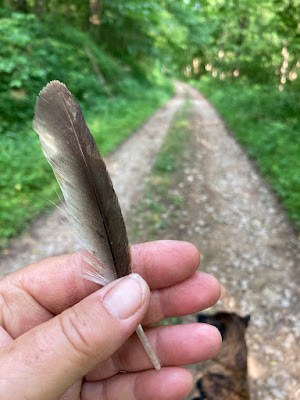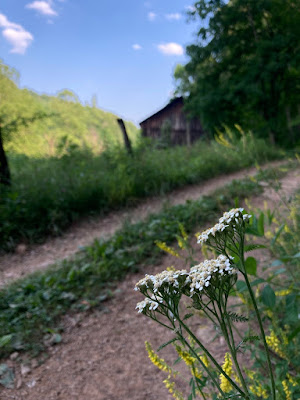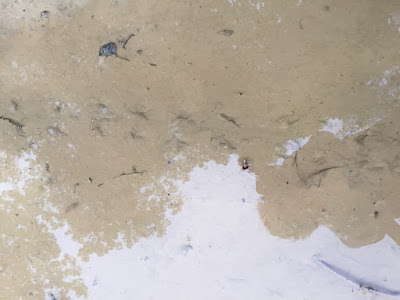One of my favorite gigs is writing nature book reviews for the Wall Street Journal. There is little I love better than getting a package in the mail from the editors there. It takes me absolutely FOREVER to read them, since I can't sit down during the day and only read at night, before I fall asleep, but I somehow manage to get it done. Then I get to say what I love about them. If I don't love a book, I won't review it, because to me, the point of a book review is to bring what's wonderful to more readers. And I have found something wonderful. It's called Finding Sanctuary. I asked Barry Van Dusen to prepare a guest blogpost about the first book he's both written and illustrated. Barry is a career natural history illustrator, and those of us who know his work have been literally slobbering, waiting for him to haul off and write his own book, illuminated by some of his gazillion field sketches and paintings he curates so meticulously in his western Massachusetts home.
 |
Skunknett River painting set-up
|
This man sketches, draws and paints from LIFE. From moving, living birds and animals, plants, insects. Outside, plein air, making landscapes appear on paper. I look at this forest scene and shrink into a fetal position, thinking about what it would take to make a watercolor of it. But Barry's like Nike. He just DOES it. And his book is an absolute masterwork, given the most lavish and sensitive treatment possible by Mass Audubon and Puritan Press in Hollis, NH. You simply MUST have it.

I have great empathy for other authors who are launching books in these upside-down days. I had the grandest book tour planned for New England (see left sidebar), and none of those events are happening now. The months Houghton Mifflin Harcourt's wonderful publicist, Maria Mann and I spent logisticizing and putting it together, the dozens of emails confirming every detail with the organizers...all for naught in 2020, and I stayed home to love my kids, feed bluebirds and raise a song sparrow instead, and that is all FINE and as it should be. But oh, I would have loved to have the chance to stump for Saving Jemima.
On one hand, maybe more people are interested and have time to read books--I'm hearing from lots of friends who are only just reading their copies of Saving Jemima, which came out in fall 2019. On the other, it's really hard to sell books when you can't give book talks. So in that spirit, I asked Barry to write a guest post about Finding Sanctuary, in the hope that you, my good readers, would consider adding a copy to your library, and maybe gifting a couple more. Here's Barry!
My work as a nature artist takes me in many directions—book illustration, lectures and teaching, studio painting and exhibitions—but the most engaging part of my job, and certainly the most fun, is outdoor drawing and painting. So when Amy Montague, director of Mass Audubon’s Museum of American Bird Art, approached me in 2014 with the idea of a Massachusetts statewide residency, I didn’t need much convincing. I would visit, paint and draw at each one of Mass Audubon’s 61 wildlife sanctuaries around the state. In previous years, I had taken part in several residency projects around New England, but this would be the most ambitious one yet. I wanted to give each Mass Audubon sanctuary the attention it deserved, and insisted on a two-year working period. In the end, the residency work spanned more than four and a half years!
In our preliminary discussions, Amy and I decided that I should not feel the need to work toward any predetermined list of species or sanctuary “specialties”, though many of the subjects I painted would fit that description. Instead, my aim would be to seize on artistic opportunities as I encountered them. This approach granted me the expressive freedom to pursue whatever piqued my curiosity, admiration, or imagination.
 |
Incubating Piping Plover, Allens Pond, p.67
|
I live in central Massachusetts, and most of the sanctuaries are within reasonable driving distance, so I typically spent a full day at each location and returned home by nightfall. Overnight trips to locations farther from home afforded me the opportunity to visit sites more than once, and to be afield at dawn and dusk—propitious times for wildlife.
 |
Smaller Purple Fringed Orchid, West Mountain p.158
|
In some instances, I timed my visits to work with very specific subjects, like the yellow lady’s slippers at High Ledges or the purple-fringed orchids at West Mountain. For places like Marblehead Neck or Sampson’s Island, I made sure to visit at the most productive times of year (when birds were passing through in the first instance, and settled onto their nests in the second). I took seasonal and weather-related factors into consideration for every visit, and studied the sanctuary maps ahead of time, hoping to maximize my time at each location.
 |
American Redstart, Marblehead Neck p. 58
|
When I first started the project, I thought I might do all of the watercolor paintings on location. I fancied I would arrive at a new sanctuary, perhaps do some drawings, paint a watercolor, and then move on to the next location. What I hadn’t anticipated was the variety and abundance of subject matter that I wanted to depict. I am not the speediest field artist (nor the slowest), but the best I can hope for in a day’s work is three finished watercolors, and more often only one or two. I realized that to do justice to the diversity I encountered in the time available, I couldn’t limit myself exclusively to fieldwork. Moreover, I realized that some of my best ideas for pictures came to me after a visit, when I’d had the leisure to mull over my experiences and ponder on the imagery. Consequently, the work you see in the book is a result of both field and studio efforts.
 |
The Horse Barn in a Spring Snowsquall, Wachusett Meadow pp. 138-139
|
I painted many BIRDS for the residency, but also worked with landscapes (some featuring Mass Audubon buildings), flowers and plants, butterflies, dragonflies and other insects, mammals, salamanders, turtles, frogs and fish. Looking at the entire body of work, I see an obvious bias toward certain subjects, and for this I make no apologies. I tell my students: Draw what you LOVE, and it will reflect in your work!
Much of what I’ve learned about the specialized craft of field painting comes from my exposure to European artists. Painting nature subjects outdoors from life is not commonly practiced here in the United States, but it’s a popular pursuit among many artists in Europe. During projects sponsored by the Artists for Nature Foundation (Netherlands), I’ve had the opportunity to work alongside some of the world’s most talented field artists. They have shown me how to select, organize and carry materials and equipment, which types of optics are most effective, and methods for working in a variety of situations. Ultimately, every field artist formulates an approach best suited to their own unique aims and temperament, but my exposure to these other artists has greatly accelerated the process of finding what works best for me.
 |
| Field Kit p. 8 |
Painting outdoors with watercolors comes with its own set of challenges, and you’ll encounter most of them in the pages of this book. On sunny days, light conditions change rapidly as the sun moves across the sky, especially in the morning and evening hours. While light conditions can be challenging, they can also become the driving force in a painting (e.g. Wings of Winter, below).
I could usually avoid rain through careful scrutiny of the forecasts, but New England weather doesn’t always play by the book. I’ve learned to carry a few sheets of plastic in my pack to quickly cover up paper and materials, and a rain jacket if the weather looks iffy. Despite these precautions, I had some frustrating sessions with rainy weather.
 |
Osprey in the Rain, North Hill Marsh p. 74
|
Cold could be mitigated by layering up properly, using warm gloves and neck gaiters, and carrying a few of those chemical hand- and foot-warmer packs. Wind joined the cold and added to the challenges at some locations. But winter conditions could also offer up rewards, like the ice storm just before my visit to Habitat, which allowed access to colorful, interesting twigs sheared from the treetops.
Humidity, both high and low, can be a serious issue for the watercolor painter. Too much moisture in the air (the more common condition in New England) slows the drying of washes and can bring progress to a standstill. Very dry conditions have the opposite effect, causing the paint to dry so quickly that there is no time to manipulate wet passages.
And then, there are the miscellaneous annoyances: biting insects and ticks, wet feet, and poisonous plants, to name a few. These are often the first memories that come to mind when I recall a particular day in the field!
 |
Swallows Over Barnstable Great Marsh p. 87
|
Some subjects lend themselves easily to location painting. It’s no accident that landscapes are the most popular subjects for outdoor painters: they stay in one place (thank you!), and offer endless variations of design and mood. All of the landscapes in this book were at least begun in the field, and many were completed on location.
Botanical subjects offer the same luxury of working time as landscapes, and could be approached in a similar manner. One obvious difference is the shift in scale—the difference between macro and micro. With plants, I usually slow down and pay more attention to morphology and details. Glancing through these pages, you’ll notice that I enjoy the details of nature. I often feel that these are too important and interesting to generalize or suggest, and am driven to record them accurately.
 |
Cinnamon Fern Fiddleheads, Nashoba Brook p. 126
|
In my opinion, studio work offers even greater opportunities for an artist’s creative side to take command. Removing myself from the fact of the subject can be liberating, allowing my imagination to take a freer hand. Studio work can also be more conceptual and carefully planned: I can combine and rearrange elements, manipulate scale, and fine-tune the balance of a composition in myriad ways.
In the studio, I can borrow freely from a variety of sources. I can refer to sketches made an hour ago or years ago. I can repaint unsuccessful field paintings, building on their strengths while avoiding faults made on the spot. I can use specimens of plants, rocks, and other natural materials, even weave in memories and associations from the past. Where field painting is intuitive, spontaneous, and improvisational, studio painting can be conceptual, cerebral, and imaginative.
 |
Wings of Winter (snow buntings), Kettle Island p. 57
|
As an artist who wishes to portray natural subjects with fidelity, my aim is to celebrate and admire the complex beauty of nature. At the same time, I want to express my wonder and awe, and retain the excitement and emotions that accompany my field encounters. To that end, I may choose to exaggerate, embellish, invent, and even distort to achieve my expressive ends. As Picasso famously said, “Art is the lie that tells the truth.” And so, I am forever seeking a balance—between field and studio, fact and expression, truth and feeling.
Here ends Barry's guest post. Zick, back with you.
Heads up: It's not cheap, but ohhh, the quality in every page. Hardcover. The paper is like satin. The design was overseen by the artist himself, every single page. The color reproduction is impeccable (same deal--Barry was on press at Puritan in Hollis, NH with it). It's an art book, a visual and sensual delight. You will be delighted you treated yourself! To order your copy of Finding Sanctuay, click https://tinyurl.com/vandusenbook
Times being what they are, Barry has had a virtual book launch. He and I recorded a half-hour interview on Zoom, where you can see us each sitting in our respective studios: me asking questions and Barry answering them. It's a lot of fun. David Sibley will also check in, and (late breaking news) so will Lars Jonsson! If you love bird art, this is a don't miss event. Here's a link to a recording of the book launch/interview:
https://www.youtube.com/watch?v=uX92I5DfMuI&feature=youtu.be






















































Saturday, June 27, 2020
4 comments